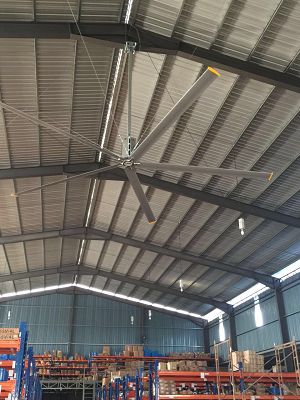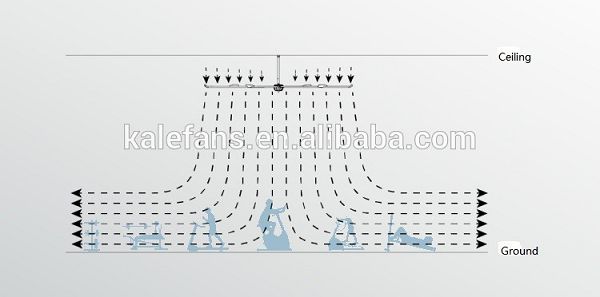Introduction

A high-volume low-speed (HVLS) fan is a type of mechanical fan greater than 7 feet (2.1 m) in diameter. HVLS fans are generally ceiling fans although some are pole mounted. HVLS fans move slowly and distribute large amounts of air at low rotational speed– hence the name "high volume, low speed."
Typical applications for HVLS fans fall into two classifications—industrial and commercial. In industrial applications, air conditioning is often cost prohibitive or impractical. Fans installed in spaces like warehouses, barns, hangars and distribution centers can prevent heat stress, increase worker comfort and the productivity of both workers and livestock. HVLS fans are also used in commercial spaces, where air conditioning is more common, but increased air movement from ceiling fans can cost-effectively augment occupant comfort or prevent stratification. Typical commercial applications include shopping malls, churches, office buildings, airport terminal buildings, fitness centers and schools.
How HVLS fans work
HVLS fans work on the principle that cool moving air breaks up the moisture-saturated boundary layer surrounding the body and accelerates evaporation to produce a cooling effect. Ceiling fans produce a column of air as they turn. This column of air moves down and out along the floor. Called a horizontal floor jet, this deep wall of horizontal moving air is relative to the diameter of a fan, and to a lesser degree, the speed of a fan. Once the floor jet reaches its potential, it migrates outward until it meets a side wall or other vertical surface.

Under ideal conditions, an 8 feet (2.4 m) diameter fan produces a floor jet of air approximately 36 inches (910 mm) deep. A 24 feet (7.3 m) diameter fan produces a floor jet 108 inches (2,700 mm) deep, tall enough to engulf a human standing on the floor or a cow, its initial development purpose.
Commercial HVLS fans differ from residential ceiling fans with regard to diameter, rotational speed, and performance. While some fans use contemporary blades to move air, other methods are being used to make it more efficient such as using airfoils.
Large fans versus small fans
Larger diameter fans can move more air than smaller fans at the same speed. A turbulent, high velocity air jet dissipates very quickly. A large column of air, however, “travels” farther than a small one due to the friction between moving air and stationary air, which occurs at the periphery of the moving column.
The perimeter of an air column varies directly with column diameter. While the cross-sectional area varies with the square of the diameter, the large column has proportionately fewer peripheries, and therefore less drag. The air column from a 3 feet (0.91 m) diameter fan, therefore, has more than six times as much friction interface per volume of air moved as does the air column from a 20 feet (6.1 m) diameter fan.
When the down column of air from an HVLS fan reaches the floor, the air turns in the horizontal direction away from the column in all directions. The air flowing outward is called the "horizontal floor jet." Since the height of the floor jet is determined by the diameter of the column of air, a larger diameter fan naturally produces a larger air column and thus a higher floor jet.
Smaller high-speed fans of equivalent displacement are incapable of producing the same effect.
The power to drive a fan increases roughly with the cube of the average air speed through the fan. A commercial fan delivering air at 20 miles per hour (mph) requires about 64 times as much power as a similar sized fan delivering air at five mph.
Airspeed, combined with fan "effectiveness," means that when the objective is to cool people or animals, very large, low-speed commercial fans are more efficient and effective than small high-speed fans.
Heating and cooling benefits
Air movement can have a significant influence on human thermal comfort. Wind chill in cold conditions is considered detrimental, but air movement in neutral to warm environments is considered beneficial. This is because normally under conditions with air temperatures above about 74°F, the body needs to lose heat in order to maintain a constant internal temperature.
Unlike air conditioners, which cool rooms, fans cool people. Ceiling fans increase air speed at the occupant level, which facilitates more efficient heat rejection, cooling the occupant, rather than the space. Elevated air speed increases the rate of convective and evaporative heat loss from the body, thus making the occupant feel cooler without changing the dry bulb temperature of the air.
Hot air is less dense than cold air, which causes hot air to naturally rise to the ceiling level through a process called convection. In still air layers of constant temperature form, the coldest at the bottom and the warmest at the top. This is called stratification. The most efficient and effective way of mixing the air in a stratified space is to push the hot air down to the occupant level. This allows for complete mixing of the air in the space while decreasing both heat loss through the building walls and roof, and building energy consumption. To avoid causing a draft, fans need to be run slowly so that air speed at the occupant level does not exceed 40 feet per minute (12 m/min).
- source Wikipedia
